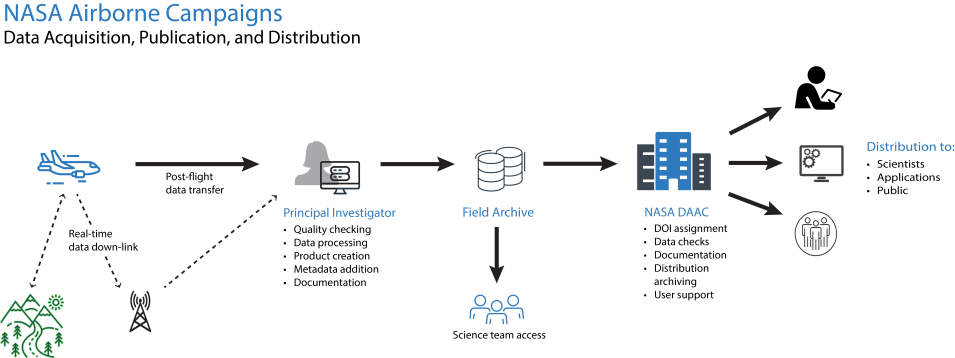The Airborne Data Management Group (ADMG) supports data producers and users of NASA airborne and field investigation data by helping to develop processes and recommended practices for airborne data handling, addition of metadata, documentation, and the discovery, distribution, and preservation of data.
NASA Earth science data and metadata standards are managed by NASA's Earth Science Data and Information System (ESDIS) Project. ADMG works with ESDIS and NASA Distributed Active Archive Centers (DAACs) to provide data producers with information and access to requirements and standards relevant to airborne and field data production and data handling.
Additional data stewardship resources are available below. Links are provided in order of highest priority. If you have questions or feel additional resources would be helpful, please contact ADMG (admg@uah.edu).
How to Provide Campaign Data to DAACs
Principal Investigators (PIs) and Campaign Data Managers
Use the following resources to help with creating an Open Science and Data Management Plan (OSDMP):
| Item | Description |
|---|---|
| Adding Data from Orbital Missions and Airborne Investigations | EOSDIS requirements for data from satellite missions, Earth Venture missions, and airborne and field investigations. |
|
Open Science and Data Management Plan (OSDMP) Template for Data Producers (PDF) |
ESDIS template for drafting an OSDMP that satisfies NASA’s Earth Science Division (ESD) requirements. |
|
Programmatic data system requirements to be utilized in Earth Venture Suborbital (EVS) investigations. |
|
|
ADMG Guide to the Data Management Plan Template for Data Producers (available on request by contacting ADMG at admg@uah.edu) |
Additional ADMG guide on drafting an OSDMP that satisfies NASA’s Earth Science Division (ESD) requirements for airborne and field investigations. |
| EOSDIS Preservation Requirements (PDF) |
Content requirements for data, metadata, and supporting documentation for NASA-funded projects to ensure their proper preservation. |
Data Producers
Individuals required to create a data product are encouraged to review the following resources:
| Item | Description |
|---|---|
| Data Producer’s Development Guide (DPDG) (PDF) |
Guidance for developing data products that align with NASA ESD requirements. |
| Earthdata Pub |
Guidance for navigating the data product publication process at a NASA DAAC. |
|
Information about assigning the appropriate Level of Service to data products. |
|
|
Additional resources for EOSDIS data standards and requirements. |
|
| ESDIS Standards Coordination Office (ESCO) Data and Metadata Standards |
Lists of ESD-approved standards and practices. |
Data Delivery and Publication Process for Airborne and Field Investigations
NASA airborne and field investigations are an important part of regional and scientifically-focused studies. The methods by which airborne and field data are observed, prepared, delivered, archived, and distributed vary from the methods used for satellite data. Most significantly, in airborne and field campaigns, individual instrument scientists are responsible for:
- Collecting data
- Structuring data products
- Checking data quality
- Transferring data to the assigned NASA DAACs
- Answering DAAC questions and reviewing data product user guides
Overall, investigation scientists bear responsibility for data product design, metadata assignment, and data formatting in line with ESDS data policies. The Data Producer’s Development Guide (DPDG) contains helpful information and considerations for data product design.
During campaigns, a field archive is used and maintained by the campaign data manager to collect and organize data and provide open access to all project science team investigators and collaborators. Within the required six-month time period from data collection, all datasets must be transferred from the field archive to the assigned DAAC for publication. DAAC personnel are responsible for the following activities:
- Checking incoming data
- Ensuring data are properly documented with metadata
- Obtaining data product Digital Object Identifiers (DOIs)
- Distributing and archiving data via the NASA cloud environment
- Providing simple user support (detailed questions are passed along to data producers)
- Performing outreach activities to notify data users of data availability
Note that, in some cases, data may be passed directly from the data producer to the DAAC without going to a field archive first. The diagram below outlines the movement of data through these various steps. Please keep in mind that data publication steps may vary by DAAC. However, significant variation in procedures should be reduced or alleviated once the Earthdata Pub tool is implemented at all DAACs (expected in 2023).
